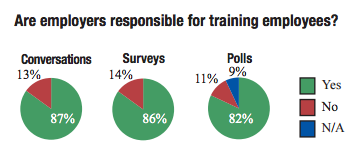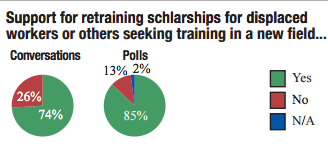Residents bullish on job training, and want employers to carry load
Residents across Michigan look into the future and can see beyond the 423,000 jobs the state lost to the Great Recession. More than 70 percent see a Michigan where the job market will rise to “good or even “great” in the coming years.
At the same time, a majority of residents agree with Gov. Rick Snyder: Many Michigan workers are in desperate need of retraining to achieve a satisfactory career, while the state’s young people need more opportunities for real work experience.
The Center for Michigan (Bridge Magazine’s parent company) spoke to more than 5,000 residents this year through 149 in-person community conversations, two telephone polls, two online surveys of employers and educators and an online panel from December through May. The findings were released this week in a report, “Getting to Work: The public’s agenda for improving career navigation, college affordability, and upward mobility in Michigan.”
In it, Michiganders said they want more attention to strategies that improve residents’ jobs prospects and upward mobility. A large majority ‒ between 74 and 91 percent of respondents ‒ favor more hands-on job training and work experience for young people, and helping adult workers find suitable retraining programs that improve their economic fortunes.
Helping workers find better jobs is a priority leaders are paying attention to beyond the state’s borders. Last week, President Obama stopped by Macomb Community College to promote a grant program that would create 34,000 apprenticeships nationally. Three Michigan programs, including MCC, would receive $11 million. It was part of the president’s push to make two years of community college free for millions of Americans.
An employer’s burden
For years, some in the business community have complained that schools are not providing students with the skills they will need to succeed in the workforce.
But in this year’s “Getting to Work” Community Conversations, Michigan residents offered something of a twist to that criticism. More than 80 percent of respondents, including small business owners, said employers need to assume more responsibility for training workers.
Even with Michigan’s unemployment rate falling below 6 percent, business groups say that some 75,000 skilled jobs go unfilled due to a lack of talent and skills in the workforce.
Michigan residents say they see the skills gap ‒ the gulf between the skills job seekers possess and the skills they need - as a huge problem. More than 70 percent of respondents said most adults need help finding out what they need to do to get the job they want.
Janie McNabb, chief operating officer for Northwest Michigan Works!, a workforce development agency in Traverse City, said the public sentiment accurately reflects the dynamics of the state’s worker pool. “I think people recognize that apprenticeship-style learning is the most effective and best way to learn and to get to better career options.”
Train youth
Michigan residents clearly view hands-on job training as essential to improving career prospects for young people: 78 percent of residents in community conversations and 83 percent of telephone respondents favor expansion of paid summer youth internships. More than nine-in-10 people support apprenticeships as a tool to improve upward mobility for both young people and older adults.
Michigan residents, however, were splintered on biggest challenges facing new workers.
Roughly 1-in-5 community conversation respondents and those contacted by phone expressed concern about a lack of available jobs for high school, college or vocational students. Roughly 23 percent of community conversation respondents and 11 percent of telephone respondents saw a lack of communication between schools, colleges and employers about the skills needed to find work. The remainder said they worried about high numbers of youth who were neither in school or in a job, while others were concerned about graduates having difficulty finding work.
Gregory Pitoniak, CEO of the Southeast Michigan Community Alliance, which operates Michigan Works! offices in Monroe and Wayne counties (excluding Detroit), said he shared anxiety about schools and employers not being on the same page on job skills.
“It’s very real that school systems need to be more proactive about career opportunities in a much broader sense,” Pitoniak said. “In fact, some schools are disinvesting in skilled trades and the types of programs that will grow in demand in the future. We also need to convince parents who have outdated notions that (their students) need to get a bachelor’s degree only.”
Old workers, new tricks
Seventy-four percent of those who attended community conversations and 85 percent of telephone respondents agreed that retraining opportunities are needed for adults in changing industries. But here again, respondents were divided on what obstacles stood in the way. Asked what makes it hard for adults to find work, 27 percent of community conversation respondents and 18 percent of telephone respondents said “not having the skills need for the job I’m looking for.” A slightly bigger group ‒ 37 percent of community conversation respondents and 50 percent of telephone respondents ‒ said “not being able to find a job that pays a livable wage.”
Pitoniak lauded a training program in the state’s southeast region called Michigan Advanced Technical Training (MAT2), where workers can get a guaranteed job, employer-paid tuition towards an associate’s degree and on-the-job training. After two years, it is now expanding to community colleges in other regions of the state.
In July, Gov. Snyder signed a bill that extends another training option, the Michigan New Jobs Training Program, until 2023. It’s part of his push to increase the number of skilled workers capable of filling the state’s backlog of unfilled positions. The program began in 2010 to allow community colleges to partner with employers to fund job training programs for their workers. Essentially, the state allows the employers to use dollars that typically are paid to the state for withholding taxes to be used instead to train employees at community colleges.
Pitoniak, who also participated in a community conversation, said such programs meet the needs of employers as well as employees.
The price of investment
As always, money will be an issue for expanding or creating training programs such as MAT2 or No Worker Left Behind.
No Worker Left Behind, funded with federal money, including stimulus funds, paid up to $10,000 of college tuition for 165,000 laid-off, unemployed or low-income Michigan adults from 2007-2010. The program cost $500 million, and two-thirds of participants reported finding employment. It is an open question whether the state would be willing to make such an investment again.
Michigan residents say they want to see more on-the-job training, and a clear majority of respondents – 80 percent – also agreed that employers should be shouldering the burden of training workers for those unfilled jobs.
Colby Cesaro, research director at the Workforce Intelligence Network of Southeast Michigan, said job training can be expensive for employers. As a result, many employers would rather pay existing workers overtime than train new ones.
Cesaro said employers would be wise to invest in training and, in return, require workers to sign an agreement that they will remain with the company for a set timeframe or repay the employer, she said. That’s a win for both the employer and the worker.
Data shows that the residents who are most bullish on Michigan’s economic future tend to be those who are more successful. Less affluent residents were more pessimistic. More than half of those with an annual household income of $35,000 or less called the current Michigan job market terrible for themselves and their relatives.
Michigan Education Watch
Michigan Education Watch is made possible by generous financial support from:
Subscribe to Michigan Education Watch
See what new members are saying about why they donated to Bridge Michigan:
- “In order for this information to be accurate and unbiased it must be underwritten by its readers, not by special interests.” - Larry S.
- “Not many other media sources report on the topics Bridge does.” - Susan B.
- “Your journalism is outstanding and rare these days.” - Mark S.
If you want to ensure the future of nonpartisan, nonprofit Michigan journalism, please become a member today. You, too, will be asked why you donated and maybe we'll feature your quote next time!


 click to enlarge
click to enlarge Michigan residents say they recognize that workers of all ages could use a boost to get the skills they need to achieve successful careers.
Michigan residents say they recognize that workers of all ages could use a boost to get the skills they need to achieve successful careers. click to enlarge
click to enlarge click to enlarge
click to enlarge
